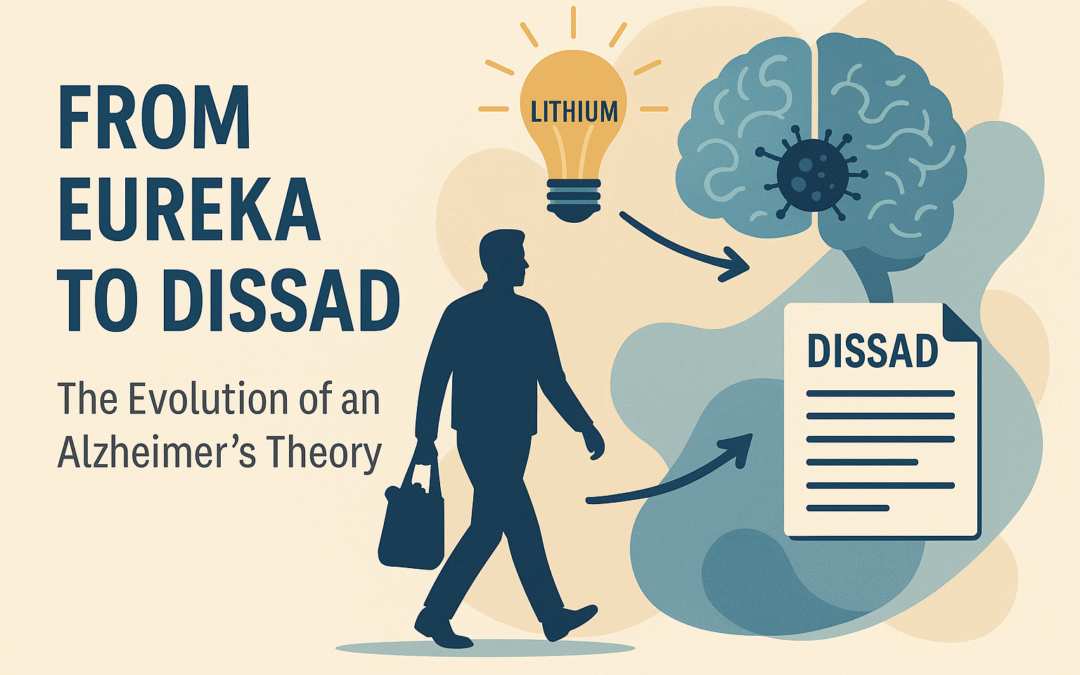Phase 1 — The Spark (April 2024)
It didn’t start in a lab.
It started on a sidewalk.
I’d been deep in Alzheimer’s research for a while — tracing the disease from the molecular chaos of amyloid-β plaques and tau tangles, to the inflammation, oxidative stress, and clearance failures that slowly dismantle the brain’s default-mode network (DMN).
I wasn’t looking at treatments yet. I was just mapping how the disease works, trying to see the hidden logic behind its progression.
And then, on the way home from the store, it hit me — a cinematic, lightbulb moment:
“LITHIUM.”
I hadn’t read a single paper about lithium in Alzheimer’s — but that would change. That night, I got to work.
That night, I wrote the first version of the theory in an email to my cousin (timestamped April 2024). It was still rough — no polished graphics, no formal predictions — but the seed was there.
Phase 2 — Going Public (May 2024)
The next month, I turned that email into a formal OSF preprint.
The second version was more than just “lithium might help”:
-
I proposed combination regimens — lithium alongside anti-amyloid, anti-tau, antioxidant, and anti-inflammatory agents.
-
I mapped potential synergy models, like bromelain + lithium + rapamycin + curcumin + piperine, targeting multiple Alzheimer’s pathways at once.
-
I speculated that the form of lithium (carbonate, orotate, etc.) might matter — that maybe its distribution in the brain was a hidden variable behind inconsistent trial results.
I still didn’t have the “sink” language or proof — just an intuition that local lithium availability could be critical.
Phase 3 — The Long Pause (Mid 2024 – Mid 2025)
And then… nothing.
Life pulled me in other directions. The lithium idea sat in my archives, public but dormant. No follow-up papers, no lab work — just a theory waiting for the right spark.
Phase 4 — The Catalyst (August 2025)
The spark came in the form of an unexpected fundraising letter from Hjärnfonden.
It got me thinking about that old OSF post. I pulled it back up, dusted it off, and decided to check what had happened in the Alzheimer’s literature since I’d written it.
That’s when I found it — the Harvard/Nature 2025 paper.
They had shown that:
-
Amyloid plaques bind lithium.
-
Tissue immediately around plaques is lithium-depleted.
-
Low-plaque-binding lithium orotate can restore downstream biomarkers at physiological exposure.
It was the missing piece. A direct, biological mechanism for the “distribution matters” hunch I’d written over a year earlier.
Phase 4 — The Catalyst (August 2025)
The spark came in the form of an unexpected fundraising letter from Hjärnfonden.
It got me thinking about that old OSF post. I pulled it back up, dusted it off, and decided to check what had happened in the Alzheimer’s literature since I’d written it.
That’s when I found it — the Harvard/Nature 2025 paper.
They had shown that:
-
Amyloid plaques bind lithium.
-
Tissue immediately around plaques is lithium-depleted.
-
Low-plaque-binding lithium orotate can restore downstream biomarkers at physiological exposure.
It was the missing piece. A direct, biological mechanism for the “distribution matters” hunch I’d written over a year earlier.
Phase 5 — The Sprint (August 2025)
With Harvard’s findings in hand, I dove back into the theory — this time as a full-blown refinement sprint.
I brought my earlier lithium work into a series of deep, iterative sessions with ChatGPT, layering in:
-
DMN-first amyloid seeding patterns.
-
Blood–brain barrier and glymphatic clearance defects.
-
The role of iron-rich microenvironments in amplifying pathology.
Out of this came DISSAD: Default-mode Network Ion Seed-and-Sink in Alzheimer’s Disease.
The model:
-
Amyloid plaques form in DMN hubs.
-
These plaques act as lithium ion sinks, binding lithium and creating local depletion zones.
-
Depletion disinhibits GSK-3β → tau hyperphosphorylation → microglial activation → network failure.
-
Severity is modulated by local iron levels and clearance efficiency.
The trial plan:
-
^7Li-MRI to map lithium distribution.
-
QSM for iron mapping.
-
Amyloid/tau PET for pathology.
-
Fluid p-tau217 slope tracking.
-
Chemistry-region interventional probes contrasting high- vs low-binding lithium.
For the first time, the theory wasn’t just a clever idea — it was falsifiable.
Phase 6 — The Wait
And now we wait
Cheers
Marcus
